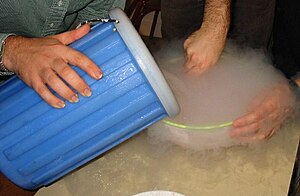Liquid nitrogen can transform oil, berries and even hamburgers
Since man’s discovery of fire, cooking has been mainly a process of subjecting food to high temperatures that chemically alter its color, taste and texture. But the invention of cryogenic technology has handed chefs an exciting new tool—liquid nitrogen—for transforming food in fun and surprising ways. In our culinary research laboratory, we use this ultra-cold liquid to cryopoach oils, cryoshatter cheese, cryopowder herbs and cryograte meat. It is great for making instant ice cream and perfectly cooked hamburgers.
For many years the coldest substance chefs had ready access to was dry ice (frozen carbon dioxide), which sublimates directly to CO2 gas at –109 degrees Fahrenheit. Although dry ice has some interesting culinary uses, its solid form limits its utility. Nitrogen boils at a far colder temperature: –321 degrees F, about as many degrees below zero as hot fryer oil is above zero. And because nitrogen melts before it vaporizes, unlike carbon dioxide, it is relatively easy to store as a liquid and pour over food or into a bowl. Because its viscosity is about one-fifth that of water and it has relatively low surface tension, liquid nitrogen flows rapidly into nooks and crannies in foods, such as hamburger patties, that have rough or irregular surfaces. The cooks at our lab use it to make fantastic burgers that are first slow-cooked to medium rare, then dunked briefly in liquid nitrogen to freeze a thin layer of the exterior and, finally, deep-fried. The deep-frying creates a perfect brown crust and thaws the frozen layer but does not overcook the interior.









